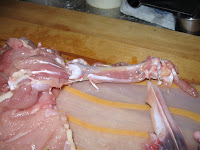I'm alone again this year and when that happens I generally feel compelled to create some approximation of a traditional holiday meal: poultry prepared whole, a starch and a vegetable or two.
This year I made a flattened pan-fried chicken, wilted mizuna, a turnip gratin and stewed roselle.

That first was from a recipe I saw on a local cooking show I saw while visiting my mother earlier this month. It's the specialty of a restaurant either in Philadelphia or Wilmington whose name I paid insufficient attention to catch. The show skipped over some details so I really only picked up a three-part technique:
1. Remove all of the chicken's bones, leaving the skin in one piece.
2. Fry it skin side down until the skin is browned and crispy.
3. Flip it to finish.
It might have struck you that step one is the tricky bit. You're not wrong about that. One further detail I did see in the show was to cut out the chicken's backbone and then squish the bird flat as if starting to butterfly it, but after that I was on my own.
I

cut the backbone a bit too narrowly, so I started with the bits remaining and sliced towards the center, under the rib cages, until I hit the clavicle to get each side off in one big piece. That went pretty smoothly and didn't slash up the meat too much. I had to dig deeper to get out the thigh bones and the keelbone and basically shredded up the chest area to get the wishbone out. Some of that required more digging around with my fingers than careful slicing with my boning knife. But here it is with the main body deboned. Not too bad. I thought chilling the chicken to firm up the meat would help, but it actually got easier to work as the bird warmed up.
Deboning

the legs and wings was a little tougher. I ended up slowly turning the legs inside out, pulling out the bone, scraping the meat off and snipping the tendons as I went along and then peeling the skin off the very end. Finally I poked my finger into the skin like an inverted rubber glove to turn it back right side out. The first joint of the wing worked similarly, but the second and third joints were hopeless so I just chopped them off and stuck them in the stockpile. (it's a pile of bones for making stock. Stockpile. Ha.)
And

there you go. One boneless chicken. I generously seasoned both sides with salt and pepper, heated up a couple teaspoons of olive oil in a 12-inch cast iron pan and dropped it in, skin side down. I started with the heat at medium-high for 15 minutes and then turned up the heat to get the skin browning. I could tell by smell when it was ready to turn. After the flip, I could see into the center of the breast meat through the slices I had pulled the wishbone out of so it was easy to judge when the thickest part was finished cooking. Around another 10 minutes.
I

removed it from the pan and let it rest a few minutes before slicing. Since it has no bones, I could slice it any way I wanted which was kind of interesting.
The chicken is amazingly flavorful, tender and juicy considering the lack of any brining or other special preparation and my random stabs at cooking times (not to mention my random stab version of butchery). The skin is wonderfully crisp and tasty. The only minus is maybe that it's rather greasy, but it's all the natural chicken fat so you can't complain too much. This turned out so very well and, although the deboning process was a bit complex, it was an engaging complexity so I didn't really mind. I think this just became my new favorite method of cooking chicken.
I wonder if it would be a good idea to remove the legs and wings. They kind of get in the way and keep the skin on the outer bits of the body from crisping, but they also prop up the thinner parts of the chicken away from the heat. That's probably important to keep them from overcooking while the breast is finishing cooking. It might be worth the experiment to compare the results.
An added bonus of this method of cooking the chicken is that you can wilt greens in the pan afterward and they soak up all the juices and crisp up at the edges. Mighty tasty. I didn't cook the mizuna quite long enough and it ended up a little chewy, but not too bad. The flavor of the greens only contributes a little to the final result given how flavorful the pan juices it's couriering are. I wouldn't try this with spinach; that would be entirely overshadowed. Mizuna, at least gets to be a bit player. Kale, finely shredded, might be even better.
All of that goodness is kind of a shame because it takes the spotlight off of the turnip gratin which turned

out fabulously in its own right.
I've got a new mandolin that does paper-thin slices easily (at least while it's still sharp) so prepping was a breeze. Here's the bottom layer--concentric overlapping circles of turnip (which is so much easier to do with properly sliced turnips, let me tell you) topped with a couple teaspoons of chicken broth, a couple Tablespoons of heavy cream, a sprinkle each of parsley, garlic and salt and a handful of shredded fontina. With the turnip slices so thin, I managed six layers from the CSA share of turnips--a bit under a pound I think--and six layers of cheese plus some grated Parmesan on top. 40 minutes at 375 degrees with foil on top and 20 without and here's the results.
Since

I went light on the liquid, the cheese isn't oozing out. Instead it mortars together the layers of just slightly toothsome turnips. The cheese and turnip flavors blend and the parsley and garlic come through adding elements of complexity and elevating the dish. You've had turnip gratin; I don't have to tell you how good it can be and this turned out to be a very fine example.
Finally, we've got the roselle. I cleaned and roughly chopped them and then stewed them in a little chicken stock. I added a little salt, but no sugar. I should have added a little sugar too. Instead of the traditional peanuts, I added some toasted pine nuts for texture.
The roselle is brightly tart and floral. Probably a bit too tart, but still quite palatable. It cuts right through the heavy fatty elements on the plate just the way it's supposed to. The pine nuts give a bit of textural contrast, but their flavor is drowned out. Not bad, but this needs a little more work.
That off note aside, this was a great meal. I regret a bit that nobody else is going to get to appreciate it. On the other hand, it's so good I really don't want to share.
Now then, what's for desert?
 the peanut butter and coconut milk. Set aside.
the peanut butter and coconut milk. Set aside. Cook 5 minutes more.
Cook 5 minutes more.














































